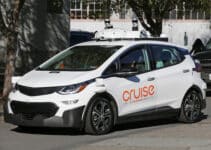Federal government data show 10 fatal crashes, each involving Tesla Inc. vehicles, were reported between June and September involving models equipped with advanced driver-assist systems.
NHTSA has reported 16 fatal crashes involving vehicles with Level 2 ADAS systems since the agency in June 2021 ordered vehicle, equipment and software manufacturers to report them. The agency and safety experts have said the data are preliminary and lack context but are still useful for transparency.
Vehicles with Level 2 systems are widely available and feature common driver assistance such as lane-centering, while fully automated Level 3-5 systems are unavailable to consumers but are being tested and deployed on a limited scale on public roads.
No fatal crashes involving fully automated vehicles have been reported since NHTSA began collecting the data.
NHTSA issued the general order to identify flaws and driver misuse and to understand how crashes occur.
ADAS and fully automated vehicle systems engaged at least 30 seconds before a crash trigger the reporting requirement.
NHTSA has reported 565 crashes involving Level 2 ADAS- equipped vehicles since July 2021.
It is important to note that Tesla may be overrepresented in the data because its vehicles remotely transmit data, while other manufacturers may find out about a crash involving driver-assist technology via a consumer, lawsuit or police report, said Michael Brooks, executive director of the Center for Auto Safety.
However, Tesla opts for confidentiality or redactions in several data fields, the NHTSA data show.
“They’re not really doing themselves any favors to clear up those incidents by redacting or seeking confidentiality for things that are pretty clearly not confidential information,” Brooks said.
That’s one of the issues of the Standard General Order, Brooks said. While it was a step toward transparency, it gives manufacturers “a lot of leeway in what’s ultimately going to be reported and certainly what’s going to be made public,” Brooks said. That makes it difficult for other agencies to evaluate the data.”
Automotive News has reached out to Tesla for comment but has not received a response.
According to the NHTSA data, four of the 10 fatal crashes involved a collision with a motorcycle.
It can be difficult for a person to detect a motorcyclist visually, Brooks said. Vehicles that rely on machine learning and camera detection, like Tesla’s, are not going to be sufficient as driverless vehicles, Brooks said, adding that this is especially dangerous when consumers are led to believe their vehicle can drive itself.
While the holes in the data make it difficult to draw conclusions, Brooks said the Center for Auto Safety has received calls from motorcyclists who are concerned about Tesla vehicles’ ability to detect them.
Issues with Tesla vehicles hitting stopped emergency vehicles led NHTSA to investigate Tesla’s advanced driver assistance system, Autopilot. The probe was aimed at the cabin camera’s ability to determine driver inattentiveness.
Driver-assist technology, in general, is plagued by three issues: A lack of consumer knowledge, varying capabilities and other drivers with no choice in the matter, Brooks said.
It’s concerning when consumers are unaware of their vehicle’s ADAS system capabilities, which differ greatly among manufacturers, Brooks said, adding that innocent drivers may suffer the consequences of consumer misuse.
“That’s really the unfair part of it … it’s really no different, in some circumstances, I guess, as a drunk driver running over a family member,” Brooks said. “You have no choice in that situation.”
Some technology doesn’t fare as well at night or in poor weather conditions, Brooks said. A recent Insurance Institute for Highway Safety study found many models’ automatic braking systems performed poorly at night.
“As NHTSA has stated consistently, no vehicle available for purchase today is capable of driving itself,” NHTSA told Automotive News in an email. “The most advanced vehicle technologies available for purchase today provide driver assistance and require a fully attentive human driver at all times performing the driving task and monitoring the surrounding environment.”
Advocates for Highway and Auto Safety has called for the federal government to issue minimum performance standards for driver-assisted technologies for a few years, said Cathy Chase, the group’s president.
“Consumers have this false sense of security and many probably think that the technology is being regulated because historically that has been what has happened,” Chase said. “But that is not what is happening now.”


